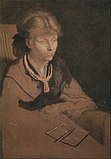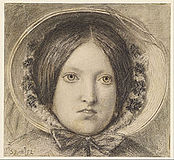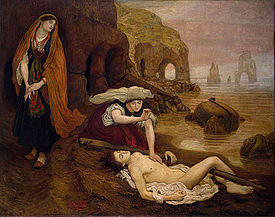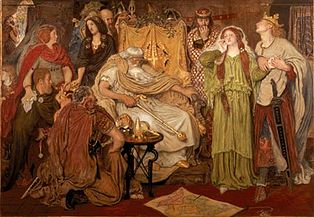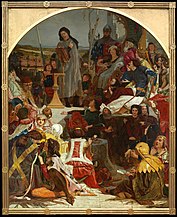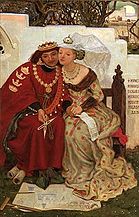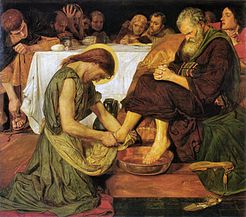Ford Madox Brown
Ford Madox Brown | |
|---|---|
 Self-portrait 1850 | |
| Born | 16 April 1821 Calais,France |
| Died | 6 October 1893(aged 72) London,England |
| Resting place | St Pancras and Islington Cemetery |
| Nationality | British |
| Known for | Painting |
| Notable work | Work (painting) The Last of England (painting) |
| Movement | Pre-Raphaelite |
| Spouses | Elizabeth Bromley
(m.1841;died1846)Emily Hill
(m.1853;died1890) |
| Children | 5, includingLucy Madox BrownandCatherine Madox Brown |
Ford Madox Brown(16 April 1821 – 6 October 1893) was a British painter of moral and historical subjects, notable for his distinctively graphic and oftenHogarthianversion of thePre-Raphaelitestyle. Arguably, his most notable painting wasWork(1852–1865). Brown spent the latter years of his life painting the twelve works known asThe Manchester Murals,depictingMancunian history,forManchester Town Hall.
Early life[edit]
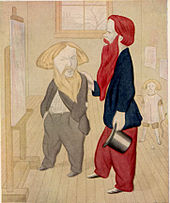
Brown was the grandson of the medical theoristJohn Brown,founder of theBrunonian system of medicine.His great-grandfather was a Scottish labourer. His father Ford Brown served as a purser in theRoyal Navy,including a period serving underSir Isaac Coffinand a period onHMSArethusa.He left the Navy after the end of theNapoleonic Wars.
In 1818, Ford Brown married Caroline Madox, of an old Kentish family.[1]Brown's parents had limited financial resources, and they moved toCalaisto seek cheaper lodgings, where their daughter Elizabeth Coffin was born in 1819 and their son Ford Madox Brown in 1821.
Brown's education was limited, as the family frequently moved between lodgings in thePas-de-Calaisand relatives inKent,but he showed artistic talent in copying ofOld Masterprints. His father initially sought a naval career for his son, writing to his former captain Sir Isaac Coffin. The family moved toBrugesin 1835 so Brown could study at the academy underAlbert Gregorius.Brown moved toGhentin 1836 to continue his studies underPieter van Hanselaere.He moved toAntwerpin 1837 to study underGustaf Wappers.He continued to study in Antwerp after his mother's death in 1839. His sister died in 1840, and then his father in 1842.
Works[edit]

The Tate Gallery holds an early example of Brown's work, a portrait of his father.[2]He first exhibited at the Royal Academy in 1840, a work inspired byLord Byron's poemThe Giaour(now lost) and then completed a version ofThe Execution of Mary, Queen of Scots,with his cousin and future wife Elisabeth Bromley as one of his models. He lived in Montmartre with his new wife and aging father in 1841. He paintedManfred on the Jungfrau,inspired by Lord Byron's poemManfredwhile he was in Paris.
In 1843 he submitted work to the Westminster Cartoon Competition, for compositions to decorate the newPalace of Westminster.His entry,The Body of Harold Brought before William,was not successful. His early works were, however, greatly admired by the youngDante Gabriel Rossetti,who asked him to become his tutor. Through Rossetti, Brown came into contact with the artists who went on to form thePre-Raphaelite Brotherhood.Though closely linked to them, he was never actually a member of the brotherhood itself, but adopted the bright colours and realistic style ofWilliam Holman HuntandJohn Everett Millais.He was also influenced by the works of Holbein that he saw in Basel in 1845, and byFriedrich OverbeckandPeter Cornelius,whom he met in Rome in 1845–46.
Brown struggled to make his mark in the 1850s, with his paintings failing to find buyers, and he considered emigrating to India. In 1852 he started work on two of his most significant works.
One of his most famous images isThe Last of England,painted from 1852 to 1855, which was sold in March 1859 for 325guineas[3](2010: £26,700). It depicts a pair of stricken emigrants as they sail away on the ship that will take them from England forever. It was inspired by the departure of the Pre-Raphaelite sculptorThomas Woolner,who had left for Australia. In an unusualtondoformat, the painting is structured with Brown's characteristic linear energy, and emphasis on apparently grotesque and banal details, such as the cabbages hanging from the ship's side. The husband and wife are portraits of Brown and his second wife Emma.

Brown's most important painting wasWork(1852–1865), begun in Hampstead in 1852 and which he showed at his retrospective exhibition in 1865.Thomas Plintadvanced funds to enable Brown to complete the work, in anticipation of obtaining the finished painting, but died in 1861 before the painting had been completed.[4]In this painting, Brown attempted to depict the totality of the mid-Victoriansocial experience in a single image, depicting 'navvies' digging up a road (The Mount, offHeath StreetinHampstead,north London) and disrupting the old social hierarchies in the process. The image erupts into proliferating details from the dynamic centre of the action, as the workers tear a hole in the road – and, symbolically, in the social fabric. Each character represents a particular social class and role in the modern urban environment.
Brown wrote a catalogue to accompany the special exhibition ofWork.This publication included an extensive explanation ofWorkthat nevertheless leaves many questions unanswered. Brown's concern with the social issues addressed inWorkprompted him to open asoup kitchenfor Manchester's hungry, and to attempt to aid the city's unemployed to find work by founding a labour exchange.[5][6]
Brown found patrons in the north of England, including Plint,George Raefrom Birkenhead,[7]John Millerfrom Liverpool, andJames Leathartfrom Newcastle. By the late 1850s he had lost patience with the poor reception he received at the Royal Academy and ceased to show his works there, rejecting an offer from Millais to support his becoming an associate member. He founded theHogarth Clubin 1858, withWilliam Morris,Edward Burne-Jones,and his former pupil Rossetti. After a successful period of a few years, the club reached over 80 members, including several prominent members of the Royal Academy, but Brown resigned in 1860, and the club collapsed in 1861.
From the 1860s, Brown also designed furniture and stained glass. He was a founder partner ofWilliam Morris's design company,Morris, Marshall, Faulkner & Co.,in 1861, which dissolved in 1874 with Morris continuing on his own. He was a close friend of the landscape artistHenry Mark Anthony.
Brown's major achievement afterWorkwasThe Manchester Murals,a cycle of twelve paintings in the Great Hall ofManchester Town Halldepicting the history of the city. Brown would be 72 by the time he finished the murals. In total, he took six years perfecting the murals, which were his last major work.[8]
Family[edit]

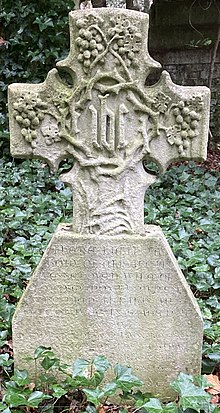
Ford Madox Brown was married twice. His first wife Elizabeth Bromley was his first cousin, the daughter of his mother's sister Mary. They were married inMeophamin Kent in April 1841, shortly before his 20th birthday and less than a year after the sudden death of his sister Elizabeth. They lived inMontmartrein 1841 with Brown's invalid father who died the following summer.
Their first child died young as an infant in November 1842. Their daughterEmma Lucywas born in 1843 and the family moved back to England in 1844. They travelled to Rome in 1845 to alleviate the illness of his wife, who was suffering from consumption (pulmonarytuberculosis). She died in Paris in June 1846, aged 27, on the journey back to England from Rome, and was buried on the western side ofHighgate Cemetery.Christina Rossetti,Elizabeth Siddaland other members of the Rossetti family were later buried alongside.
Emma Hill became a frequent model for Brown from 1848; for example, she is the wife inThe Last of England.She became his mistress, and they shared a house in London, but social convention discouraged him from marrying an illiterate daughter of a bricklayer. Their daughterCatherine Emilywas born in 1850, and eventually they were married atSt Dunstan-in-the-Westin April 1853. Ford leased a house inFitzroy Square.[9]
Their son,Oliver Madox Brown(1855–1874) (known as Nolly) showed promise both as an artist and poet, but died ofblood poisoningbefore his maturity. The death of Nolly was a crushing blow for Brown, and he kept a room for his son's belongings as a shrine. Another son Arthur was born in September 1856. Brown used Arthur as the model for the baby held by a ragged girl in the foreground ofWork,but he died aged only ten months old in July 1857.
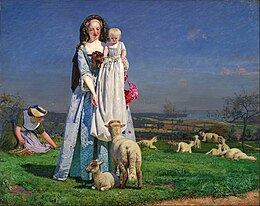
His daughtersLucy Madox BrownandCatherine Madox Brownwere also competent artists. Lucy marriedWilliam Michael Rossettiin 1874. Catherine, marriedFrancis Hueffer;through Catherine, Brown was the grandfather of novelistFord Madox Fordand great-grandfather ofLabourHome SecretaryFrank Soskice.
Death[edit]
Brown's second wife died in October 1890, and he died in Primrose Hill, north London, in 1893. He is buried in theSt Pancras and Islington CemeteryinEast Finchley.He was given a secular funeral, and the funeral oration was delivered by the AmericanMoncure D. Conway,the secularist after whomConway Hallwas later named.[10]
- The Brown family
-
Brown's first surviving daughter Lucy in 1849
-
Catherine Madox Brown
-
Oliver in 1855
-
Arthur in 1856
-
Emma in 1852 (study forThe Last of England)
-
Ford Madox Brown,1867, drawn byDante Gabriel Rossetti
Legacy[edit]
The Ford Madox Brown, aJ D Wetherspoonpubin Oxford Road,Manchester,is named after Ford Madox Brown.[11]It states on the Wetherspoon's website that "This J D Wetherspoon pub is named after the much-travelled artist Ford Madox Brown, a one-time resident of Victoria Park, a suburb south of the pub." The pub opened in 2007.
Gallery[edit]
- Ford Madox Brown's works
-
James Leathart
-
Traveller,1868
-
The Irish Girl,1860
-
Cromwell, Protector of the Vaudois,1877
-
Finding ofDon Juanby Haidee,1873
-
Cordelia's Portion
-
Byron's Dream
-
The French saint KingLouis IXin the stained glass of the East window ofAll Saints Church, Cambridge
-
Chaucerat the Court ofEdward III,oil on canvas painting by Ford Madox Brown, 1847–1851,Art Gallery of New South Wales
-
Romeo and Julietparting on the balcony in Act III.Delaware Art Museum,1870
-
Brown'sJacob and Joseph's CoatatMuseo de Arte de Ponce,Ponce, Puerto Rico
-
King Rene's Honeymoon,1864, an imaginary scene in the life of the art-loving medieval kingRené of Anjou.
-
Jesus washing Peter's feet
See also[edit]
References[edit]
- ^Rossetti, William Michael(1911)..Encyclopædia Britannica.Vol. 4 (11th ed.). pp. 657–658.
- ^"Tate.org".
- ^Sale of Valuable Pictures,The Times,28 March 1859
- ^Dianne Sachko Macleod, 'Plint, Thomas Edward(1823–1861)',Oxford Dictionary of National Biography,Oxford University Press, Sept 2004
- ^Fiona MacCarthy (31 August 2012)."Why the pre-Raphaelites were the YBAs of their day".The Guardian.Retrieved11 September2012.
- ^"Biography of Ford Madox Brown-Social conscience".Manchester Art Gallery. 2009. Archived fromthe originalon 20 December 2014.Retrieved11 September2012.
- ^"George Rae, 1817-1902".University of Glasgow.Retrieved24 June2016.
- ^Hughes, Kathryn (16 September 2011)."Ford Madox Brown: pre-Raphaelite pioneer and working-class hero".The Guardian.Retrieved8 November2011.
- ^"Fitzroy Square Pages 52-63 Survey of London: Volume 21, the Parish of St Pancras Part 3: Tottenham Court Road and Neighbourhood. Originally published by London County Council, London, 1949".British History Online.Retrieved4 August2020.
- ^TLS(8/10/2008).
- ^"The Ford Madox Brown, Manchester | Our Pubs".J D Wetherspoon. 17 December 2007.Retrieved13 April2012.
Sources[edit]
| External videos | |
|---|---|
 | |
- Virginia Surtees(ed.),The Diary of Ford Madox Brown,1981,ISBN0-300-02743-5.
- Kenneth Bendiner,Ford Madox Brown: Il Lavoro,Turin: Lindau, 1991.
- Kenneth Bendiner,The Art of Ford Madox Brown,University Park, PA: Penn State Press, 1998.
- Tessa Sidey (ed.),Ford Madox Brown: The Unofficial Pre-Raphaelite,Birmingham Museum and Art Gallery, 2008,ISBN978-1-904832-56-0.
- Julian Treuherz,Ford Madox Brown: Pre-Raphaelite Pioneer,Philip Wilson Publishers, 2011,ISBN978-0-856677-00-7,p. 12.
- Angela Thirlwell,Into the Frame: The Four Loves of Ford Madox Brown,Pimlico, 2011,ISBN978-1-844139-14-9.
External links[edit]
- The iBiblio Web Museum exhibit on Brown
- Some of his paintings in theCarol Gerten Fine Artlibrary
- Waiting: An English fireside of 1854–5
- Spartacus Educational:Ford Madox Brown
- Chronology on Britain Unlimited
- Some stained glass designs by Ford Madox Brown
- Ford Madox Brown in theHistory of ArtArchived30 September 2010 at theWayback Machine
- Phryne's list of pictures in public galleries
- Photo of Ford Madox Brown's grave and a brief article about his time in Finchley
- The Pre-Raph PackDiscover more about the artists, the techniques they used and a timeline spanning 100 years.
- Ford Madox Brown: PreRaphaelite PioneerExhibition, Manchester Art Gallery, Saturday 24 September 2011 – Sunday 29 January 2012
- "The secret love of Ford Madox Brown":essay on Ford Madox Brown and Mathilde Blind, by Angela Thirlwell, fromTLS,8 October 2008
- Birmingham Museums & Art Gallery's Pre-Raphaelite Online ResourceArchived27 June 2012 at theWayback Machineincludes almost two hundred paintings on canvas and works on paper by Ford Madox Brown
- Tim Barringer,'Brown, Ford Madox (1821–1893)',Oxford Dictionary of National Biography,Oxford University Press, 2004; online edn, May 2005accessed 2 May 2014
- Biography of Ford Madox Brown,Manchester Art Gallery
- 78 artworks by or after Ford Madox Brownat theArt UKsite


